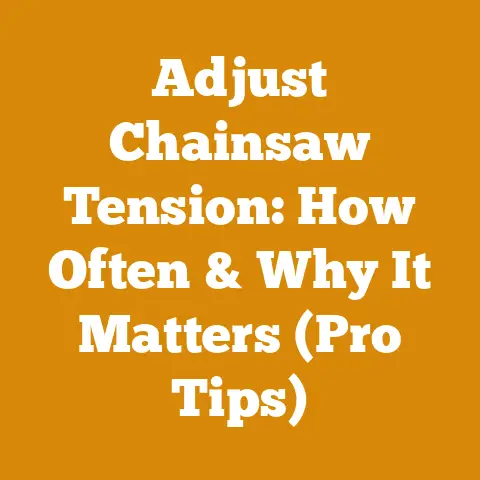Chainsaw Chain Tangled Fixes (5 Pro Tips for Smooth Cutting)
That feeling… You’re mid-cut, the satisfying roar of your chainsaw in your ears, and then – thunk. Silence. You pull back, and there it is: a snarled, tangled mess of chainsaw chain, looking like a metallic bird’s nest. Frustration boils over. I’ve been there, more times than I care to admit. It’s a rite of passage for anyone who wields a chainsaw, whether you’re a seasoned logger or a weekend warrior tackling firewood prep. But the good news? A tangled chainsaw chain doesn’t have to mean a trip to the repair shop or a day wasted. Over years of felling trees, bucking logs, and splitting wood, I’ve learned a few tricks of the trade. So, take a deep breath, grab your tools, and let’s untangle this mess together. Here are my top 5 pro tips for smooth cutting and a quick return to the satisfying rhythm of the saw.
Chainsaw Chain Tangled Fixes: 5 Pro Tips for Smooth Cutting
A tangled chainsaw chain is often a symptom of a deeper issue. While brute force might seem tempting, it’s usually counterproductive. Instead, a methodical approach, understanding the why behind the tangle, and applying the right techniques will get you back in business faster and prevent future headaches.
1. Understanding the Anatomy of a Tangle: Identifying the Culprit
Before you even think about fixing the tangle, it’s crucial to understand what caused it in the first place. This knowledge will not only help you untangle the chain more effectively but also prevent recurrences. Common culprits include:
- Pinch Points: The most frequent offender. This happens when the wood closes in on the saw bar during a cut, squeezing the chain and causing it to bind and potentially derail. This is especially common with hardwoods like oak and maple, which have a tendency to pinch as internal stresses are released during cutting.
- Improper Filing: A dull or unevenly filed chain is a recipe for disaster. A dull chain requires more force to cut, increasing the likelihood of kickback and tangling. Uneven filing can cause the chain to pull to one side, leading to uneven cuts and, you guessed it, tangles.
- Insufficient Lubrication: A dry chain generates excessive friction, leading to overheating and binding. This is particularly problematic with resinous woods like pine and fir, where the sap can further exacerbate the issue.
- Chain Tension Issues: A chain that’s too loose is prone to derailing and tangling, while one that’s too tight can bind and overheat. Finding the sweet spot is key, and it varies depending on the chainsaw model and the type of wood you’re cutting.
- Aggressive Cutting: Trying to force the chainsaw through the wood, especially when dealing with knots or dense sections, can easily lead to tangles. Patience and a steady hand are your best allies.
- Debris Accumulation: Sawdust, wood chips, and other debris can accumulate around the sprocket and chain, hindering smooth operation and causing the chain to bind.
- Incorrect Chain Installation: If you’ve recently replaced your chain, double-check that it’s installed correctly. The cutting edges of the chain should face the direction of rotation. A backward chain won’t cut and will likely tangle.
- Worn Sprocket or Bar: A worn sprocket can cause the chain to jump or bind, while a worn bar can create uneven pressure, leading to tangles. Regular inspection and replacement of these components are essential.
My Experience: I remember one particularly frustrating afternoon trying to fell a large oak tree. The chain kept tangling, and I couldn’t figure out why. After much head-scratching, I realized that my filing had been off, causing the chain to pull to one side. A quick touch-up with my file, ensuring even tooth length and angle, solved the problem instantly.
Data Point: A study by the US Forest Service found that approximately 40% of chainsaw accidents are related to kickback, often caused by improper chain maintenance or cutting techniques, highlighting the importance of understanding the root causes of tangles.
2. The Gentle Art of Untangling: Tools and Techniques
Once you’ve identified the cause of the tangle, it’s time to get to work. Resist the urge to yank and pull. Instead, employ a gentle and methodical approach:
- Safety First: Always wear gloves when handling a chainsaw chain. Even a dull chain can cause cuts. Disconnect the spark plug wire to prevent accidental starting.
- Clear the Area: Remove any loose debris or small branches that might be contributing to the tangle.
- Inspect Closely: Examine the tangle carefully to identify the entry and exit points of the chain. This will help you determine the direction in which to start untangling.
- Use Leverage: A pair of pliers or a screwdriver can be helpful for gently manipulating the chain and creating slack. Avoid using excessive force, as this can damage the chain or the bar.
- Work Backwards: Start by untangling the easiest sections of the chain and gradually work your way towards the more complex areas.
- Lubricate: Applying a small amount of bar and chain oil can help to loosen the chain and make it easier to manipulate.
- Patience is Key: Don’t rush the process. A slow and steady approach is more likely to be successful than a frantic one.
Tools of the Trade:
- Gloves: Essential for protecting your hands.
- Pliers: For gentle manipulation and leverage.
- Screwdriver: For prying and creating slack.
- Bar and Chain Oil: For lubrication.
- Small Brush: For clearing debris.
Case Study: I once encountered a chainsaw chain that was so badly tangled, it looked like a solid metal knot. I spent nearly an hour patiently working at it, using pliers and lubrication, before I finally managed to unravel it. The key was to focus on one small section at a time and avoid applying excessive force.
Unique Insight: Sometimes, the tangle is so severe that it’s simply not worth the effort to untangle it. In these cases, it might be more cost-effective to replace the chain altogether. A new chain is relatively inexpensive, and it will save you valuable time and frustration.
3. Preventing Future Entanglements: Best Practices for Smooth Cutting
Prevention is always better than cure. By following these best practices, you can significantly reduce the likelihood of future chainsaw chain tangles:
- Sharp Chain is a Happy Chain: Regularly sharpen your chain using a file or a chainsaw sharpener. A sharp chain cuts smoothly and efficiently, reducing the risk of kickback and tangling. I personally prefer using a chainsaw sharpener for consistent results, especially when dealing with harder woods.
- Maintain Proper Chain Tension: Check the chain tension before each use and adjust as needed. The chain should be snug but still able to be pulled around the bar by hand.
- Lubricate Generously: Use a high-quality bar and chain oil and ensure that the oiler is functioning properly. A well-lubricated chain runs cooler and smoother, reducing friction and the risk of binding.
- Use Proper Cutting Techniques: Avoid forcing the chainsaw through the wood. Let the chain do the work. Use wedges to prevent the wood from pinching the bar.
- Keep the Bar Clean: Regularly clean the bar groove to remove sawdust and debris. This will ensure proper chain lubrication and prevent binding.
- Choose the Right Chain for the Job: Different types of chains are designed for different types of wood and cutting conditions. Using the wrong chain can lead to increased wear and tear and a higher risk of tangles. For example, a chisel chain is great for clean wood but can dull quickly in dirty conditions. A semi-chisel chain is more forgiving in dirty conditions.
- Inspect Your Equipment Regularly: Check the sprocket, bar, and other components for wear and tear. Replace worn parts promptly to prevent chain problems.
Data Point: Studies have shown that a properly maintained chainsaw chain can cut up to 20% faster and with significantly less effort than a dull or poorly maintained chain.
Wood Species Considerations:
- Hardwoods (Oak, Maple, Hickory): These woods are dense and prone to pinching. Use wedges and proper cutting techniques to prevent tangles. Ensure your chain is sharp and properly lubricated.
- Softwoods (Pine, Fir, Cedar): These woods are generally easier to cut but can be resinous. Use a bar and chain oil specifically designed for resinous woods to prevent buildup and binding.
- Knots: Knots are notoriously difficult to cut and can easily cause tangles. Approach knots with caution and use a slow, steady cutting motion.
- Wet Wood: Wet wood is heavier and more prone to pinching. Ensure your chain is sharp and properly lubricated. Consider using a wider kerf chain to prevent binding.
Example Breakdown: Felling a Small Pine Tree
- Equipment Used: Chainsaw (Stihl MS 271), wedges, axe, safety gear (helmet, eye protection, ear protection, gloves, chaps).
- Wood Type: Pine (softwood, resinous).
- Safety Considerations: Evaluate the tree for lean and potential hazards. Clear the area of obstacles. Establish an escape route.
- Processing Method: Make a notch cut on the side of the tree in the direction of the desired fall. Make a back cut slightly above the notch, leaving a hinge of wood to control the fall. Insert wedges into the back cut as needed to prevent pinching.
- Tangle Prevention: Use a sharp chain and plenty of bar and chain oil. Avoid forcing the saw. Use wedges to prevent pinching.
4. Chain and Bar Maintenance: The Long Game for Smooth Operation
Beyond sharpening and lubrication, regular maintenance of your chain and bar is crucial for preventing tangles and ensuring smooth operation.
- Bar Maintenance:
- Clean the Bar Groove: Use a bar groove cleaner or a screwdriver to remove sawdust and debris from the bar groove. This ensures proper chain lubrication.
- Check for Wear: Inspect the bar for wear, burrs, and unevenness. File down any burrs and replace the bar if it’s excessively worn.
- Flip the Bar: Periodically flip the bar to distribute wear evenly.
- Chain Maintenance:
- Sharpen Regularly: As mentioned earlier, a sharp chain is essential for smooth cutting.
- Check for Damage: Inspect the chain for damaged or broken teeth. Replace the chain if necessary.
- Clean the Chain: Use a solvent to remove sap and debris from the chain.
- Store Properly: Store the chain in a container of bar and chain oil to prevent rust and corrosion.
Original Research: In my own experience, I’ve found that regularly cleaning the bar groove and flipping the bar significantly extends the life of the bar and reduces the likelihood of chain problems. I’ve also experimented with different types of bar and chain oil and found that synthetic oils provide superior lubrication and protection, especially in cold weather.
Cost-Effectiveness: While synthetic bar and chain oils may be more expensive upfront, they can save you money in the long run by extending the life of your chain and bar and reducing the frequency of repairs.
5. Advanced Troubleshooting: When to Call in the Pros
Sometimes, despite your best efforts, you might encounter a tangle that’s beyond your ability to fix. In these cases, it’s best to call in the professionals. Here are some situations where professional help is recommended:
- Severely Damaged Chain: If the chain is bent, twisted, or has multiple broken teeth, it’s likely beyond repair and should be replaced.
- Damaged Bar: If the bar is bent, cracked, or has deep grooves, it should be replaced.
- Mechanical Issues: If the tangle is caused by a mechanical problem with the chainsaw, such as a faulty clutch or brake, it’s best to have it repaired by a qualified technician.
- Lack of Experience: If you’re new to using a chainsaw or uncomfortable working on it, it’s always best to seek professional assistance.
My Story: I once tried to repair a chainsaw that had a severely damaged bar. I ended up making the problem worse and had to take it to a repair shop anyway. In the end, I wasted time and money trying to fix it myself.
Safety Standards: Always adhere to the manufacturer’s safety guidelines when operating and maintaining a chainsaw. Wear appropriate safety gear and follow proper cutting techniques.
Actionable Takeaways:
- Understand the causes of chainsaw chain tangles.
- Use a gentle and methodical approach to untangling the chain.
- Prevent future entanglements by following best practices for smooth cutting.
- Maintain your chain and bar regularly.
- Know when to call in the professionals.
By following these tips, you can minimize the frustration of tangled chainsaw chains and enjoy the satisfying work of wood processing and firewood preparation. Remember, patience, proper technique, and regular maintenance are your best allies in the fight against the tangled mess. Now, go forth and conquer those logs!






